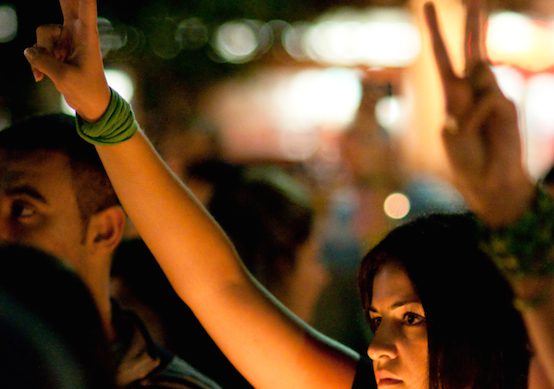Contesting the Iranian Revolution: Understanding the Green Movement

Iran’s Green movement was the largest popular protest since the revolution of 1978-79, and it was the most significant domestic upheaval in the history of the Islamic Republic. But what was its relationship to the revolution, and how did it use the imagery and slogans of the Islamic Republic in protest against that same government? These are some of the questions that Pouya Alimagham answers in Contesting the Iranian Revolution: The Green Uprisings, his outstanding study of the uprisings of 2009 and 2010. While the uprisings failed in overturning the results of the 2009 election, they constituted a major mobilization of millions of Iranians who belonged to a long Iranian tradition of demanding their political rights and resisting government abuses. The Green movement anticipated the broader upheavals that took place in the next decade across the region, and to some extent served as an inspiration for those later uprisings. The Green movement is also one of the most frequently misunderstood and misrepresented political movements in recent history, so this book is a very welcome addition to the debate.
Alimagham reviews the Islamic Republic’s founding to show how the Green movement protesters used the earlier protests in the revolution as models, and then he shows how movement activists took over and subverted the slogans and images that were central to their government’s claims to legitimacy. Instead of simply rejecting the state’s slogans and appeals to religious authority, the movement adapted them to their own purposes and used them against the government. Through each successive chapter, Alimagham follows the development of the uprisings from the beginning in June 2009 until the end of the protests the following year, and using the social media and video records created by the activists he details how they took the government’s own revolutionary rhetoric and symbols and made them their own. The result is an informative and subtle account of a significant political movement in recent Iranian history that still has relevance for the internal political debates inside Iran today.
The book begins with an introduction to the history of the Islamic Republic beginning with the events of the revolution and the political developments inside the new system leading up to 2009. The story hinges on the 2009 election, of course, and both the campaign leading up to it and the initial reaction to Ahmadinejad’s questionable “victory” are covered at length. From there we are immersed in the thought and arguments of Green movement activists and writers. The final two chapters show how Green movement activists made use of the government’s official rhetoric and symbolism. The first focuses on the activists’ use of the issue of Palestine and the celebration of Quds Day to challenge the government. One set of activists attacked the government’s support for Palestine because they saw it as hypocritical when the government was abusing its own people, and another group more explicitly likened the struggle of the protesters to that of the Palestinians and cast the Iranian government in the role of the oppressive occupier. It is the second group in particular that Alimagham focuses on and he describes it as the “more consequential” of the two. These activists were engaged in a kind of “political jiu-jitsu,” as he says. Directly comparing themselves with Palestinians, they used slogans such as, “Why are you sitting when Iran has become Palestine?” and “Enough killing–whether in Iran or Gaza.” Alimagham comments:
The power of these slogans and signs lay in the belief that if what was happening in Palestine was unjust, as the Iranian government has stressed for three decades, then how could the injustice transpiring in Iran be acceptable? (p. 184)
Green movement protesters would do something very similar with the official rhetoric and symbolism surrounding the Ashura commemoration of the death of the third imam, Husayn, at Karbala at the hands of the caliph Yazid and his followers. The protesters not only used the occasion of Ashura to organize large protests, but they co-opted the message of resistance to injustice and oppression that was at the heart of the commemoration. The commemoration of Husayn’s martyrdom that year happened to coincide with the mourning days for the Grand Ayatollah Hussein Ali Montazeri, who had been one of the original creators of the Islamic Republic and was at one time Khomeini’s expected successor before falling out of favor. In the twenty years since he fell out of favor with the government, Montazeri had been an acerbic critic of the system’s failings and abuses, so it was fitting that protesters against that system mourned for him and transformed that mourning into political action. Montazeri’s own criticisms echoed and anticipated the protesters’ grievances with the government, and they were in some respects picking up where he left off. Before he died, Montazeri had already spoken out in opposition to the election result and the ensuing crackdown, and the protesters then seized the opportunity to speak up for him and their own cause after his death.
Alimagham has done a fine job of understanding and explaining the ideas and motivations of Green movement activists largely on their own terms and using their own words. It is an important work of scholarship, and anyone that wants to understand modern Iran better would benefit from reading it. This study deepened and improved my own understanding of the modern political scene in Iran, and I think it will be a valuable reference work for a long time to come.
Comments